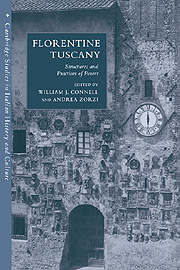Book contents
- Frontmatter
- Contents
- List of figures
- List of tables
- List of abbreviations of archival sources
- Introduction
- 1 The ‘material constitution’ of the Florentine dominion
- 2 The language of empire
- 3 Constitutional ambitions, legal realities and the Florentine state
- 4 Fiscality, politics and dominion in Florentine Tuscany at the end of the middle ages
- 5 Market structures
- 6 State-building, church reform and the politics of legitimacy in Florence, 1375–1460
- 7 The humanist citizen as provincial governor
- 8 Territorial offices and officeholders
- 9 Demography and the politics of fiscality
- 10 Florentines and the communities of the territorial state
- 11 Patronage and its role in government: the Florentine patriciate and Volterra
- 12 San Miniato al Tedesco: the evolution of the political class
- 13 The social classes of Colle Valdelsa and the formation of the dominion (fourteenth–sixteenth centuries)
- 14 Arezzo, the Medici and the Florentine regime
- 15 Rubrics and requests: statutory division and supra-communal clientage in Pistoia
- 16 A comment
- Index
- CAMBRIDGE STUDIES IN ITALIAN HISTORY AND CULTURE
14 - Arezzo, the Medici and the Florentine regime
Published online by Cambridge University Press: 16 September 2009
- Frontmatter
- Contents
- List of figures
- List of tables
- List of abbreviations of archival sources
- Introduction
- 1 The ‘material constitution’ of the Florentine dominion
- 2 The language of empire
- 3 Constitutional ambitions, legal realities and the Florentine state
- 4 Fiscality, politics and dominion in Florentine Tuscany at the end of the middle ages
- 5 Market structures
- 6 State-building, church reform and the politics of legitimacy in Florence, 1375–1460
- 7 The humanist citizen as provincial governor
- 8 Territorial offices and officeholders
- 9 Demography and the politics of fiscality
- 10 Florentines and the communities of the territorial state
- 11 Patronage and its role in government: the Florentine patriciate and Volterra
- 12 San Miniato al Tedesco: the evolution of the political class
- 13 The social classes of Colle Valdelsa and the formation of the dominion (fourteenth–sixteenth centuries)
- 14 Arezzo, the Medici and the Florentine regime
- 15 Rubrics and requests: statutory division and supra-communal clientage in Pistoia
- 16 A comment
- Index
- CAMBRIDGE STUDIES IN ITALIAN HISTORY AND CULTURE
Summary
On 4 June 1502 the city of Arezzo rebelled against Florentine rule, maintaining an independent government until 25 August. Since the establishment of Florentine dominion in 1384, there had been a number of attempts to restore independence to Arezzo. At the core was normally a group of malcontented patricians, resentful of Florentine dominance, of the loss of communal liberty and of exploitative taxation. In 1502 there were several problems which rendered Florentine control over Arezzo particularly precarious. Florentine territorial authority was seriously weakened by the successful rebellion of Pisa in 1494, followed the next year – and even closer to Arezzo – by the loss of Montepulciano to Siena. Attempts to regain these dominions exhausted Florentine resources, and, moreover, there is documentary evidence that Pisa and Montepulciano provided examples for Arezzo in 1502. Another problem was that in 1502 gram was in short supply in Florentine dominions and it had been necessary previously to move substantial stocks to feed Florentine troops lodged near Borgo San Sepolcro and needed to protect against a possible attack from hostile forces in Umbria; there was considerable anxiety among the Aretine populace lest the Florentines should do this again and leave Arezzo to starve. Another difficulty for Florence was the weakness of local support.
- Type
- Chapter
- Information
- Florentine TuscanyStructures and Practices of Power, pp. 293 - 311Publisher: Cambridge University PressPrint publication year: 2000
- 1
- Cited by



